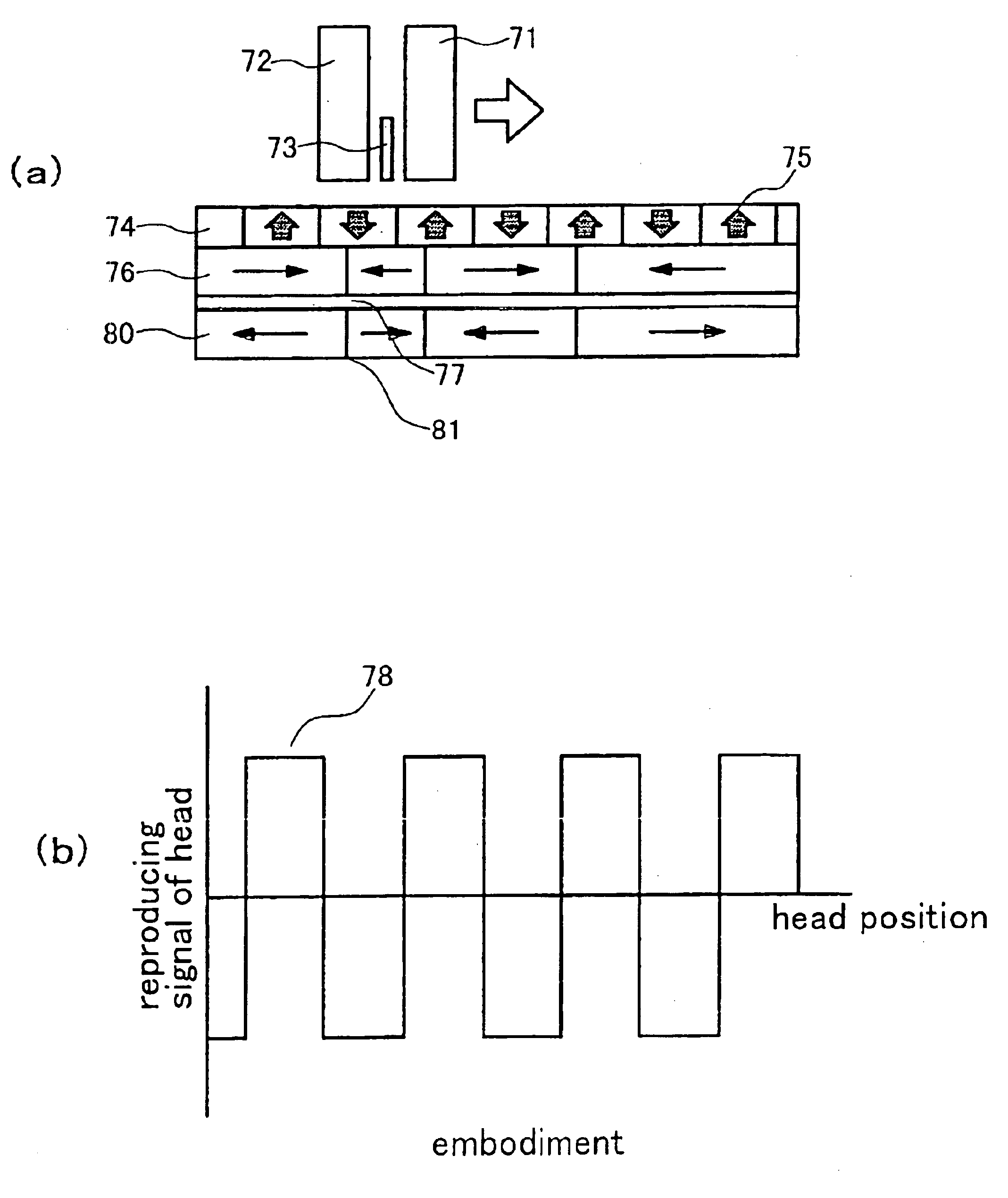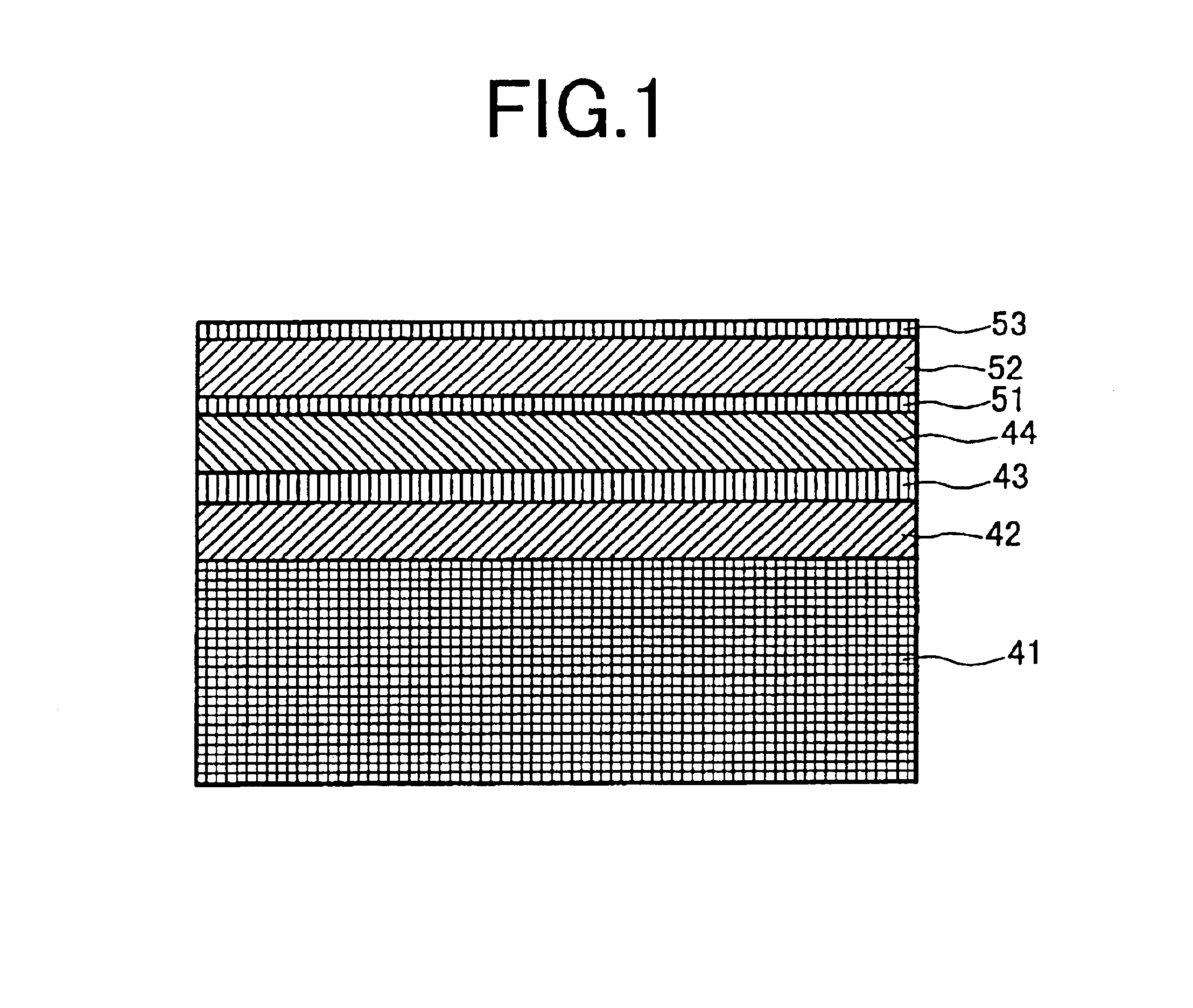Perpendicular magnetic recording medium and magnetic storage apparatus
- Summary
- Abstract
- Description
- Claims
- Application Information
AI Technical Summary
Benefits of technology
Problems solved by technology
Method used
Image
Examples
example 1
[0028]Using a glass substrate having a diameter of 2.5 inches, a magnetic recording medium having a cross-sectional structure as illustrated in FIG. 1 was produced by a DC magnetron sputtering method. A magnetic under layer including a first layer 42, a second layer 43 and a third layer 44 was formed on a substrate 41. A perpendicular magnetic layer (CoCrPt) 52 having a thickness of 25 nm and a protective layer 53 having a thickness of 5 nm were formed in this order on the magnetic under layer via an intermediate under layer (TiCr) 51 having a thickness of 5 nm. Two different media were produced, one in which the first layer 42 and the third layer 44 were both made of Co with a thickness of 30 nm, and the other in which the first layer 42 and the third layer 44 were both made of CoFe with a thickness of 30 nm. In both media, the second layer 43 was made of Ru.
[0029]FIG. 2A to FIG. 3B illustrate the results of measurements performed for the Ru layer thickness dependency of the magnet...
example 2
[0041]A magnetic storage apparatus as illustrated in FIG. 9 was produced by using a disk (FIG. 7) obtained by depositing the perpendicular magnetic recording medium of Example 1 on both sides of a substrate, and a read / recording head (FIG. 8) having a high efficiency read back element based on the giant magnetoresistive (GMR) effect.
[0042]The magnetic storage apparatus is of a well-known structure and includes a magnetic recording medium (disk) 91, a driving section 92 for rotating the magnetic recording medium 91, a magnetic head 93 having a magnetic write section and a read back section, a magnetic head driving section 94 for relatively moving the magnetic head 93 with respect to the magnetic recording medium 91, a signal processing section 95 for processing signals read / written by the magnetic head 93, and a load / unload mechanism 96.
[0043]FIG. 7 is a schematic cross-sectional view illustrating the disk. The disk includes a substrate 27 made of NiAl, a magnetic layer 26 (26′) made...
example 3
[0045]Another evaluation was made while using a different perpendicular magnetic recording medium with the magnetic storage apparatus schematically illustrated in FIG. 9. FIG. 10 is a schematic cross-sectional view illustrating the perpendicular magnetic recording medium. The perpendicular magnetic recording medium includes a substrate 101 made of glass, a Co layer 102 having a thickness of 40 nm, an Ru layer 103 having a thickness of 0.7 nm, a Co layer 104 having a thickness of 40 nm, a Co-based amorphous ferromagnetic layer 105 having a thickness of 20 nm, a non-magnetic intermediate layer 106 having a thickness of 2 nm, a perpendicular magnetic layer 107 made of CoCrPtB and having a thickness of 30 nm, and a protective layer 108 made of carbon and having a thickness of 3 nm. The layers 102 to 108 are deposited in this order on the substrate 101.
[0046]In the perpendicular magnetic recording medium, the portion from the Co layer 102 to the Co-based amorphous ferromagnetic layer 105...
PUM
 Login to View More
Login to View More Abstract
Description
Claims
Application Information
 Login to View More
Login to View More - R&D
- Intellectual Property
- Life Sciences
- Materials
- Tech Scout
- Unparalleled Data Quality
- Higher Quality Content
- 60% Fewer Hallucinations
Browse by: Latest US Patents, China's latest patents, Technical Efficacy Thesaurus, Application Domain, Technology Topic, Popular Technical Reports.
© 2025 PatSnap. All rights reserved.Legal|Privacy policy|Modern Slavery Act Transparency Statement|Sitemap|About US| Contact US: help@patsnap.com



